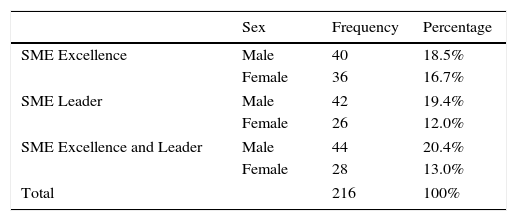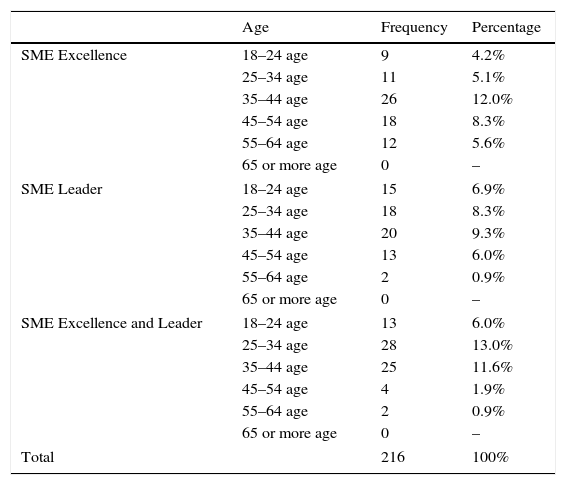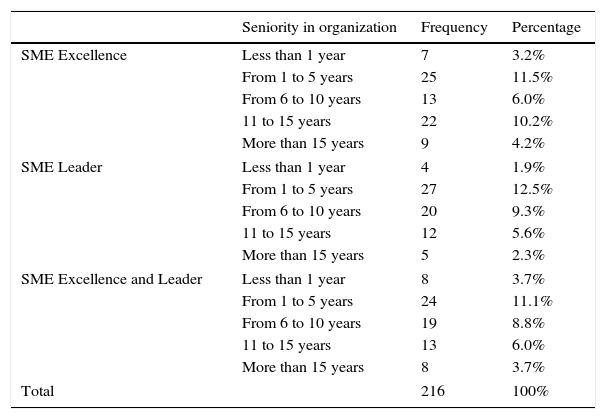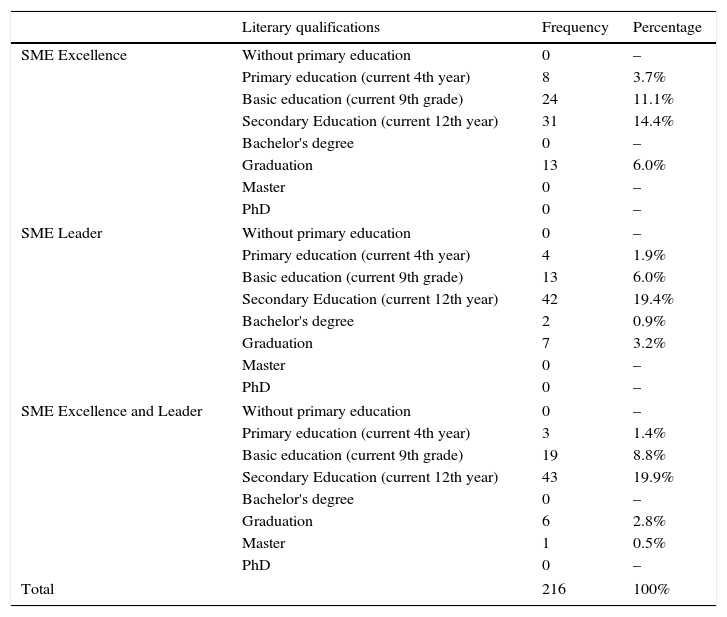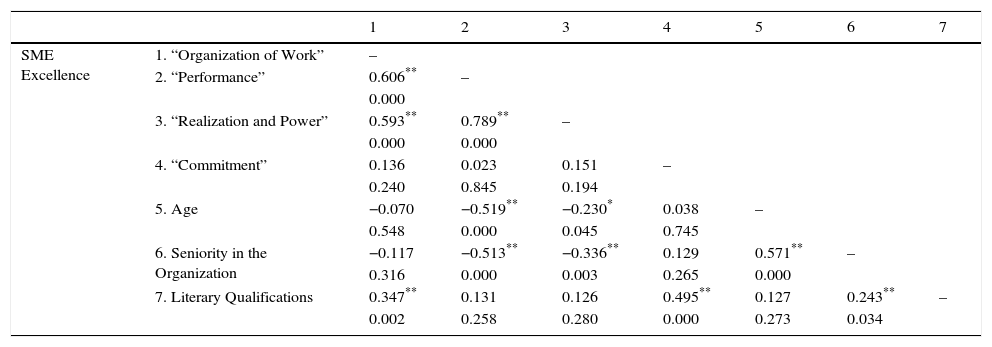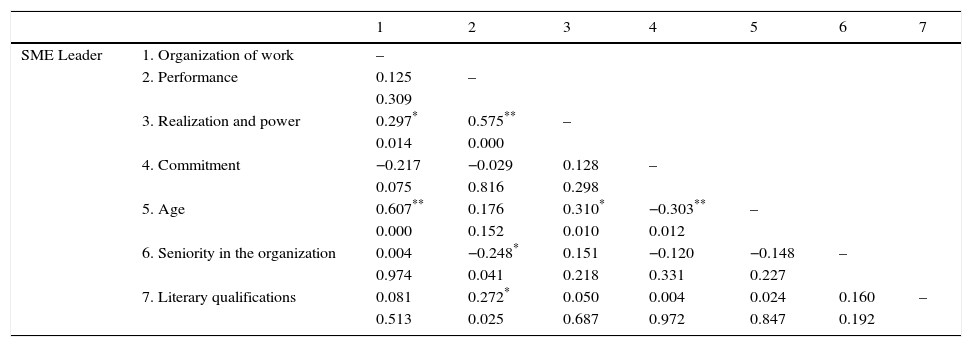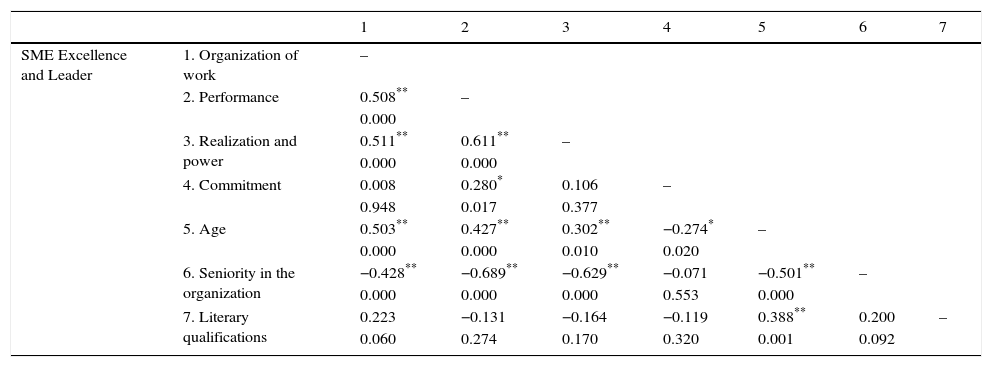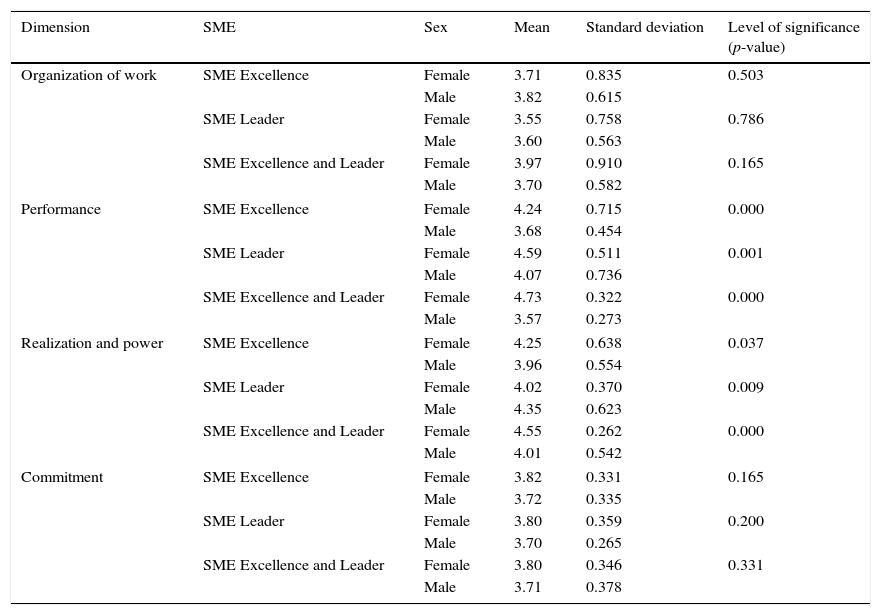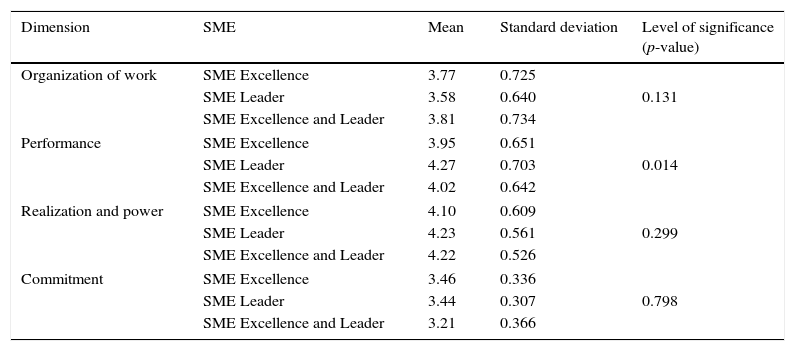This study intends to quantitatively and qualitatively evaluate the motivation of the employees of three Portuguese Small and Medium Enterprises (SMEs) with the statutes of Excellence, Leader and both statutes. These statutes were assigned by the Institute for Support to Small and Medium Enterprises and Innovation. A questionnaire was applied in 2016 based on the Multi-Factorial Scale and a brief interview with the managers of these Portuguese companies was conducted. It was found that the dimensions “work organization” and “commitment” presented lower results in the three companies, while the other dimensions had higher ones in terms of motivation at work. Only in the “performance” dimension were there significant differences in motivation at work that occurred between SME Leader and SME Excellence. It should be noted that, according to the results obtained, both in the opinion of managers and employees, the statutes did not contribute to motivation at work.
Over the years, motivation at work has been presented as a central variable in organizational life. It is an essential variable that contributes to the employee acting in a certain way, since it is related to their good performance and to achieve goals (Howard, Gagné, Morin, & Broeck, 2016; Kanfer, Frese, & Johnson, 2017).
The word motivation derives from the Latin movere, meaning “to move,” that is, the movement that leads to action (Steers, Mowday, & Shapiro, 2004).
For Pinder (2008), motivation is understood as an energetic set of forces of the individual, which relate to the work behavior and determine its form, direction, intensity and duration, that is, motivation at work results from the interaction between the person and the environment, since it is a central concept in the context of organizational behavior.
Chiavenato (2010: p. 242) states that it is “a basic psychological process. Along with perception, attitudes, personalities and learning, motivation stands out as an important process in understanding human behavior. It interacts and acts in conjunction with other mediating processes and the environment. As with cognitive processes, motivation cannot be visualized.”
Subsequently, Ferreira, Neves, and Caetano (2011) define this concept as the equivalent of the desire to adopt high levels of effort in order to achieve organizational goals, provided that such efforts lead to the satisfaction of some individual need.
People take into consideration more than monetary reward or personal interests at work, since it does not constitute a cost to workers. They prefer to get involved in meaningful work, considered rewarding and useful, and feel rewarded in their work, which stimulates the continuity of work behaviors, generating positive emotions (Thomas, 2009).
In sum, according to Gibson, Ivancevich, Donnelly, and Konopaske (2012), the concept of motivation leads to several conclusions, that is, today theorists have slightly different interpretations, with emphasis on the different factors; the concept of motivation is closely related to the behavior and performance of workers; motivation certainly involves goals and objectives; results from events and processes that are internal or external to the worker; and finally, research on motivation is still evolving, and many aspects of human motivation are still unexplained.
According to Pritchard, Harrell, DiazGranados, and Guzman (2008), establishing goals and the visibility of the efforts made to recognize the usefulness of their work are also important factors for workers and have a motivating effect. Thus, workers feel motivated for a given task resulting from needs, stimuli, interests, expectations, and thus can refer to two types of motivation: the intrinsic and the extrinsic.
It is understood by intrinsic motivation, situations in which rewards are not necessarily given, that is, it is related to the tasks that satisfy the worker alone; corresponding to internal goals (Arias, 2004).
This type of motivation can also be called personal or unconscious motivation, that is, it is motivation that comes from the worker himself and is driven by the interest or pleasure of the task itself, not depending on any type of external pressure (Salanova & Kirmaen, 2010).
On the other hand, according to Tapia (1997), extrinsic motivation is related to external goals, that is, situations in which behavior results from the purpose of only receiving a reward or avoiding any kind of punishment. In these situations, the worker is mainly concerned with his image, since the external environment influences the control of behavior, not the motivational factors inherent neither to the worker nor to the task, but only the result of the interaction between both.
Since the 1950s several theories and much relevant research on human motivation have been developed. According to Neves (1998), it is fundamental to understand human behavior, hence the multiplicity of theories that deal with motivation, mainly in the search for the reason behind individual actions.
The main objective of this study is to assess the antecedents that explain the motivation of the employees of the three organizations and to evaluate if the statute obtained had an influence on motivation, improvements in working conditions, increase in productivity and performance and public recognition. To attain this purpose, a questionnaire was applied to a sample of 216 employees of three Portuguese companies in 2016.
This paper is organized as followed. In the second section, the main theories of motivation, the most commonly used measures of motivation and the criteria used to assign the statutes are presented. The methodology is described in the third section, while the estimated results are reported and discussed in the fourth section.
2Literature review2.1Theories of motivationThe various motivation theories have different points of view (Ferreira & Martinez, 2008). Thus, motivation theories are classified according to two major groups: content theories and process theories. The former seek to explain motivation through the analysis of motivational factors, focusing on the question: “what motivates the workers”, that is, explains the human motivation from the needs of the individual, stating that the conduct is oriented to their satisfaction. Process theories analyze motivation in a more dynamic way, seeking above all to answer the questions: “how motivated behavior takes place”, “how motivation is created and sustained in the long run”, understand motivation as a decision-making process, in which perceptions, objectives, expectations and personal goals are at stake (Cunha, Rego, Cunha, Cabral-Cardoso, & Neves, 2014).
There are indeed many theories about motivation at work. The theoretical framework of this study was limited to the use of some of the most important theories of motivation, which are explained below.
In 1961, McClelland developed a theory focused on acquired needs, that is, “the needs that people develop through their experience, throughout their lives, that is, the needs acquired socially as they interact with their environment” (Teixeira, 2005: p. 150). This theory reports on three basic motives or needs in the dynamics of human behavior, namely (McClelland, 1961): needs of achievement, power needs and needs of affiliation.
According to a study by McClelland, with a base of more than five hundred managers, “the most effective managers have a great need for power, a more moderate need for accomplishment and a less need for a friendly relationship” (Teixeira, 2005: p. 151).
Hackman and Oldham developed the Work Design Model in 1974. They identified five characteristics of work that influence performance and contribute to making the function a source of motivation (Hackman & Oldham, 1974):
Variety: degree in which the function requires the use of skills, activities, diversified knowledge, talents and different skills on the part of the worker in order for the work to be carried out.
Identity: the degree to which the function requires the execution of an identifiable work unit, with principle and purpose and that produces a visible result, that is, allows the worker to identify with what he produced.
Meaning: impact of work on the lives of others, either in the organization itself or in the external environment. The greater the impact, the greater the meaning of work.
Autonomy: it represents the level of independence in the planning of work and its execution, that is, the degree to which the work provides freedom and that allows the worker to plan the work itself and the procedures to be used for it to be carried out.
Feedback: refers to the quantity and quality of the information received on the progress in the execution of the work and the levels of performance achieved.
Locke and Latham developed Goal Setting Theory in 1968, which argues that the best way to increase employee productivity is by defining or setting goals or goals and controlling their outcomes, once objectives are established, one can motivate the person within the organization (Locke & Latham, 1990).
Locke and Latham (1990) found that the most effective of all objectives are the ones that combine the characteristics of the SMART acronym, that is:
S for specific, the objectives must be specific, easy to understand and well defined so that its implementation is viable;
M for measurable, the objectives must be measurable, it must be possible to quantify them, see their evolution, so that they can make changes. The agreed, but also attainable, goals should be achievable, however does not mean that they have to be easy, but also cannot be impossible, as it can cause frustration and discouragement;
R for realistic, realistic objectives must be defined, but they must be feasible;
T for timed, the objectives must be achieved in a certain period of time, a deadline must be set for them to be achieved.
However, according to Cunha et al. (2014), there is criticism toward Locke and Latham's theory. The first criticism refers to the fact that people focus on their goals and can jeopardize interpersonal relationships and cooperation, neglecting cooperative aids that may delay their achievement. The second criticism concerns the possibility that the workers do not have sufficient capacity to achieve the objectives, which cancels the motivating effects.
In short, this theory suggests that performance differences between individuals performing a task for which they have the necessary skills and knowledge are mainly due to the different performance objectives of each.
The Multi-Factor Motivation Scale at Work also evaluates Allen and Meyer's Three-Dimensional Model, it approaches the employee's commitment to the organization, since it is a determinant measure of productivity, associated as an element that contributes strongly to motivation at work (Allen & Meyer, 1990).
In this way, Allen and Meyer (1990, 1991) propose the “Model of the Three Components of Organizational Commitment”, which simultaneously shows the affective, instrumental and normative component:
Affective: concerns the identification, involvement and emotional attachment of the worker to the organization.
Instrumental: refers to the importance of the costs inherent in leaving the organizations, that is, workers remain in the organization because they need to do so.
Normative: it is reflected in the feeling of “obligation” to continue in the organization, that is, workers committed to the organization expose certain behaviors because they believe to be the most morally correct.
Commitment is a measure that determines productivity and contributes to motivation at work, since organizations need people who are committed and prepared to participate in decision-making (Allen & Meyer, 1991).
2.2Measures of motivation at workThe various studies on motivation at work show how important it is for managers to understand why their employees are motivated or demotivated. Therefore, there are some measures that managers can access to assess the behavior of individuals, such as motivation at work, Job Diagnostic Survey by Hackman and Oldham (1974) and the Multi-Moti Multi-Factor Motivation Scale in the Work of Ferreira, Diogo, Ferreira, and Valente (2006).
The Job Diagnostic Survey (JDS), developed by Hackman and Oldham (1974), covers 5 dimensions: meaning, variety, identity, autonomy and feedback.
According to Hackman and Oldham (1974), the questionnaire helps determine how work can best be designed by obtaining information about how people react to different types of jobs. This questionnaire measures the various characteristics of the work, the reactions of the interviewees in relation to their jobs and the need for growth of the interviewees. The questionnaire is divided into 7 sections. The questions are designed to get perceptions of the individual's work and their reactions to it.
Ferreira et al. (2006) created the Multi-Factor Motivation Scale at Work with the objective of making and developing a psychological assessment tool that measures motivation at work, based on some classic theories of motivation: the Hackman and Oldham Function Character Model, McClelland's Acquired Needs Theory, Locke's and Latham's Goal-Setting Theory, and Allen-Meyer's Three-Dimensional Model.
The scale includes 28 items resulting from a theoretical research. These items evaluate four dimensions related to work motivation, that is, work organization, performance, reasons of accomplishment and power and involvement in the organization (Ferreira et al., 2006).
2.3SMEs Leader and SMEs Excellence: criteria for its classificationAccording to the Institute for Support to Small and Medium-sized Enterprises and Innovation (IAPMEI), Micro, Small and Medium-sized Enterprises (SMEs) are those companies that cumulatively meet the requirements regarding number of employees and turnover.
Thus, a company is classified as a small enterprise if it has less than 50 employees and a turnover or total balance of 10 million euros or less and, finally, an average enterprise if it has less than 250 employees and a turnover equal to or less than EUR 50 million and a balance sheet total of EUR 43 million or less (IAPMEI, 2007).
According to IAPMEI (2016a), the SMEs Leader status must meet the following criteria:
- (a)
Companies providing SMEs status, in accordance with the Community Recommendation of 6 May 2003 (2003/361/EC), to be proved by obtaining the online SME Certification, which must be renewed annually to date legal limit of presentation of the Simplified Business Information (IES) to the Tax Authority, under penalty of automatic expiration;
- (b)
SMEs that have completed at least three full years of activity and have closed accounts for 2015;
- (c)
Have a regularized situation before the Tax Authority, Social Security, IAPMEI and Tourism of Portugal;
- (d)
SMEs that pursue growth strategies and strengthen their competitive base, selected through the superior capacity of scrutiny of a wide implantation in the national territory, by the registered banks;
- (e)
SMEs that have a rating assigned by the Bank's internal credit rating system that proposes the application, consistent with the superior scrutiny capacity required above;
- (f)
SMEs which demonstrate high levels of performance and financial soundness and which, on the basis of the elements referred to in point (b) above, demonstrate the cumulative verification of the following conditions:
- (i)
Positive Net Profit in 2015;
- (ii)
Positive EBITDA over the two years under review (2015 and 2014);
- (iii)
Financial Autonomy in 2015≥30% (Equity/Assets);
- (iv)
Net Return on Shareholders’ Equity≥1% (Net Result/Equity);
- (v)
Net Debt/EBITDA≤5% (Net Debt/EBITDA);
- (vi)
EBITDA/Assets≥1%;
- (vii)
EBITDA/Turnover≥1%;
- (viii)
Turnover in 2015≥1,000,000.00 (1 million euros);
- (ix)
Number of employees (AWU) of the company as self-employed in 2015≥8.
- (i)
The selection of SMEs Excellence by IAPMEI and Tourism of Portugal is based on the universe of SMEs Leader as of October 30, 2016, which meets the following criteria cumulatively (IAPMEI, 2016b):
- (i)
Financial Autonomy in 2015≥137.5% (Equity/Assets);
- (ii)
Net Return on Shareholders’ Equity≥12.5% (Net Result/Equity);
- (iii)
Net Debt/EBITDA≤2.5% (Net Debt/EBITDA);
- (iv)
EBITDA/Assets≥10%;
- (v)
EBITDA/Turnover≥7.5%;
- (vi)
Growth in Turnover≥0%.
The purpose of this research is to assess the level of motivation of the employees of different types of organizations, SMEs Excellence, SMEs Leader or with both statutes attributed by IAPMEI and research if there are differences in the motivation of the employees. Specific objectives are as follows:
- i.
To determine the level of importance attributed to the “Organization at Work” dimension, according to Hackman and Oldham's theory, to the Realization and Power dimension “according to McClelland's theory, to the” Performance “dimension, according to Locke and Latham's theory, to “Commitment” dimension, according to Allen and Meyer's theory;
- ii.
Identify if there are changes in the behavior of employees, after obtaining status, motivation, productivity, performance, improvement of working conditions, and the degree of importance that the public recognition brought to companies;
- iii.
Determine, from the manager's point of view, whether there are significant differences after the attribution of the SMEs Excellence, SMEs Leader or both status in the motivation of the employees and has influenced the quality of the products and/or services provided.
Thus, the Multi-Moti Scale of Ferreira et al. (2006), since it is a validated measure in a Portuguese sample and based on the work of Hackman and Oldham, McClelland, Latham and Locke and Allen and Meyer.
For the development of this study, in a quantitative perspective, and taking into account that motivation at work stands out as an important process in the understanding of human behavior, the most appropriate methodology was the execution of a closed-response questionnaire, according to Multi-Moti – Multi-Factor Scale of Work Motivation, and in a qualitative perspective the elaboration of an interview with the managers of a SME Excellence, a SME Leader and a SME Excellence and Leader, through a request for collaboration.
The companies targeted for the study are three. SME Excellence is made up of 76 employees from the industry sector, dedicated to the production and commercialization of ceramic materials; the SME Leader is made up of 68 employees of the transport sector, it is dedicated to the transport of national and international goods, operating particularly in Europe; the SME Excellence and Leader is made up of 72 employees of the commerce sector, it is dedicated to the commercialization of construction materials.
The questionnaire was delivered to 224 employees and 217 responses were obtained, of which 216 were valid, resulting in a response rate of 96.4%.
3.1Brief description of the methods of data collectionThe questionnaire was developed according to Multi-Moti – Multi-Factor Scale of Motivation at Work and, in paper format, being organized as follows:
- -
Items 1, 5, 9, 13, 17, 21 and 25 measure motivation with regard to “work organization”. This dimension seeks to know the degree of satisfaction of the employee in terms of working conditions and remuneration, as well as the sense of accomplishment with the functions that he/she performs, feedback received and participation in decision making;
- -
Items 2, 6, 10, 14, 18, 22 and 26 are associated with the motivation for “performance”. This dimension seeks to understand if the periodic evaluations motivate the employee and if he likes to see his performance evaluated, the importance of showing emotion in the performance of the tasks, the development of strategies to reach the goals and the diversity of the tasks;
- -
Items 3, 7, 11, 15, 19, 23 and 27 evaluate dimensions referring to the “realization and power” motives. This dimension seeks to know the importance of career perspectives, the degree of responsibility of the functions and the existence of awards attributed to the best collaborators;
- -
Finally, items 4, 8, 12, 16, 20, 24 and 28 refer to aspects of motivation related to “commitment”. This dimension seeks to know the employee's level of motivation, the monotony of work, the emotional involvement with the organization, the importance of the knowledge and the identification with the function that it performs.
From the 28 items that make up the scale, items 8, 20 and 28 find the question posed in the negative, so they should be reversed (Ferreira et al., 2006).
Next, items 29 to 33 refer to the SME Excellence/SME Leader Statute, which seeks to assess whether the statute helped motivate employees, improved working conditions, recognized the meaning of public recognition, and increased performance and productivity in the job. These issues were of own elaboration.
All these statements are associated with a Likert type response scale with five types of alternative responses, whose response positions oscillate between 1 – totally disagree, 2 – disagree, 3 – do not disagree or agree, 4 – agree and 5 – totally agree.
In a final part, there are a set of questions regarding the respondents’ age, gender, seniority in the organization and literary qualifications. It is important to note that the questionnaire is anonymous and restricted to the study in question.
The application of this questionnaire occurred during the months of July and August of 2016 through the paper delivery to the manager of the company. The analysis of the obtained results was through the software IBM SPSS Statistics 20.
Based on the purpose of the study, the interview was conducted to each of the managers of each SME, whether Excellency, Leader or both statutes, with the aim of seeking to understand the manager's position as well.
Thus, the interview was composed of 5 open-ended questions in which it was sought to determine whether, after obtaining the aforementioned statutes, the motivation of the employees changed, if there were differences in productivity and performance, if the motivation influenced the quality of the products and/or services and finally, if the companies had the objective to obtain the statutes again next year.
4ResultsThe data was entered into a database in the IBM SPSS Statistics 20 statistical program.
The profile of the sample under study at the demographic level was analyzed in four variables: gender, age, seniority in the organization and literacy.
Regarding the sex of the respondents, and according to Table 1, it can be shown that, in general, there was a greater participation in the study of the male respondents, with 58.3%, in all 126 employees and with the lowest percentage of female employees with 41.7%, 90 employees.
Regarding the age of the employees who participated in the study (Table 2), the predominant age group is between 35 and 44 years old, with 12% and 9.3% respectively, in relation to SME Excellence and SME Leader. SME Excellence and Leader scored the highest percentage in the 25–34 age group with 13% of the respondents.
Age of respondents.
| Age | Frequency | Percentage | |
|---|---|---|---|
| SME Excellence | 18–24 age | 9 | 4.2% |
| 25–34 age | 11 | 5.1% | |
| 35–44 age | 26 | 12.0% | |
| 45–54 age | 18 | 8.3% | |
| 55–64 age | 12 | 5.6% | |
| 65 or more age | 0 | – | |
| SME Leader | 18–24 age | 15 | 6.9% |
| 25–34 age | 18 | 8.3% | |
| 35–44 age | 20 | 9.3% | |
| 45–54 age | 13 | 6.0% | |
| 55–64 age | 2 | 0.9% | |
| 65 or more age | 0 | – | |
| SME Excellence and Leader | 18–24 age | 13 | 6.0% |
| 25–34 age | 28 | 13.0% | |
| 35–44 age | 25 | 11.6% | |
| 45–54 age | 4 | 1.9% | |
| 55–64 age | 2 | 0.9% | |
| 65 or more age | 0 | – | |
| Total | 216 | 100% | |
However, at the other extreme, SME Excellence is the respondent aged between 18 and 24 years, representing 4.2%, and in relation to SME Leader and SME Excellence and Leader, aged 55–64, who registered 0.9% of the employees of these SME. Based on the age of respondents, it is possible to verify that most of them are in a middle age (25–54 years).
Table 3 shows the variable seniority. In terms of seniority in the organization, employees are generally in the “1–5 years” organization, with values higher than the other categories for all SME, with 11.5%, 12.5% and 11, 1%, respectively.
Seniority in the organization.
| Seniority in organization | Frequency | Percentage | |
|---|---|---|---|
| SME Excellence | Less than 1 year | 7 | 3.2% |
| From 1 to 5 years | 25 | 11.5% | |
| From 6 to 10 years | 13 | 6.0% | |
| 11 to 15 years | 22 | 10.2% | |
| More than 15 years | 9 | 4.2% | |
| SME Leader | Less than 1 year | 4 | 1.9% |
| From 1 to 5 years | 27 | 12.5% | |
| From 6 to 10 years | 20 | 9.3% | |
| 11 to 15 years | 12 | 5.6% | |
| More than 15 years | 5 | 2.3% | |
| SME Excellence and Leader | Less than 1 year | 8 | 3.7% |
| From 1 to 5 years | 24 | 11.1% | |
| From 6 to 10 years | 19 | 8.8% | |
| 11 to 15 years | 13 | 6.0% | |
| More than 15 years | 8 | 3.7% | |
| Total | 216 | 100% | |
However, the “less than 1 year” category recorded the lowest figures taking into account the other categories, with 3.2%, 2.9% and 3.7% respectively, as well as the “more than 15 years” category, which also had a lower value, with 3.7% of the respondents in relation to SME Excellence and Leader.
Regarding the educational qualifications of the respondents (Table 4), the highest percentage is found in secondary education and basic education, representing a total of 53.7% and 25.9% respectively.
Literary qualifications of the respondents.
| Literary qualifications | Frequency | Percentage | |
|---|---|---|---|
| SME Excellence | Without primary education | 0 | – |
| Primary education (current 4th year) | 8 | 3.7% | |
| Basic education (current 9th grade) | 24 | 11.1% | |
| Secondary Education (current 12th year) | 31 | 14.4% | |
| Bachelor's degree | 0 | – | |
| Graduation | 13 | 6.0% | |
| Master | 0 | – | |
| PhD | 0 | – | |
| SME Leader | Without primary education | 0 | – |
| Primary education (current 4th year) | 4 | 1.9% | |
| Basic education (current 9th grade) | 13 | 6.0% | |
| Secondary Education (current 12th year) | 42 | 19.4% | |
| Bachelor's degree | 2 | 0.9% | |
| Graduation | 7 | 3.2% | |
| Master | 0 | – | |
| PhD | 0 | – | |
| SME Excellence and Leader | Without primary education | 0 | – |
| Primary education (current 4th year) | 3 | 1.4% | |
| Basic education (current 9th grade) | 19 | 8.8% | |
| Secondary Education (current 12th year) | 43 | 19.9% | |
| Bachelor's degree | 0 | – | |
| Graduation | 6 | 2.8% | |
| Master | 1 | 0.5% | |
| PhD | 0 | – | |
| Total | 216 | 100% | |
Analyzing Table 5, according to the employees’ perception, it is verified that the most valued dimension is the “Realization and Power”, since it presents an average by size of more than 4 in relation to all SME under analysis.
Motivation in the work by dimension.
| Dimension | SME Excellence | SME Leader | SME Excellence and Leader | |||
|---|---|---|---|---|---|---|
| Mean | Standard deviation | Mean | Standard deviation | Mean | Standard deviation | |
| “Organization of Work” | 3.77 | 0.88 | 3.58 | 0.81 | 3.81 | 0.90 |
| “Performance” | 3.95 | 0.82 | 4.27 | 0.87 | 4.02 | 0.82 |
| “Realization and Power” | 4.10 | 0.78 | 4.23 | 0.74 | 4.22 | 0.78 |
| “Commitment” | 3.77 | 0.99 | 3.73 | 0.95 | 3.75 | 0.98 |
At the opposite end and with worse performance, according to the employees’ perception, the dimensions “Organization of Work” and “Commitment”, with averages below 4 are analyzed when analyzing all the SME together.
In general, the “work organization” dimension is more relevant when analyzed in SME Excellence and Leader with an average of 3.81. The “performance” dimension is given greater importance when analyzed in the SME Leader with an average of 4.27, as well as the dimension “realization and power” with an average of 4.23. Finally, the dimension “commitment” registered a lower average than the others, its value is relevant when analyzed the SME Excellence.
Later, a correlation was made between work motivation and age, motivation at work and seniority in the organization, motivation at work and literacy. As the variables are ordinal, the Spearman coefficient (r) was used (Marôco, 2011).
In Table 6, it can be seen that in SME Excellence, the higher the employees’ age, the smaller the “performance” dimension (r=−0.519; p<0.01), that is, the company's older employees attribute (Locke & Latham, 1990), and smaller the dimension “realization and power” (r=−0.230; p<0.05), that is, do not have the need to receive immediate feedback or to be successful in performing relatively complex tasks (McClelland, 1961).
Bivariate correlations – SME Excellence.
| 1 | 2 | 3 | 4 | 5 | 6 | 7 | ||
|---|---|---|---|---|---|---|---|---|
| SME Excellence | 1. “Organization of Work” | – | ||||||
| 2. “Performance” | 0.606** | – | ||||||
| 0.000 | ||||||||
| 3. “Realization and Power” | 0.593** | 0.789** | – | |||||
| 0.000 | 0.000 | |||||||
| 4. “Commitment” | 0.136 | 0.023 | 0.151 | – | ||||
| 0.240 | 0.845 | 0.194 | ||||||
| 5. Age | −0.070 | −0.519** | −0.230* | 0.038 | – | |||
| 0.548 | 0.000 | 0.045 | 0.745 | |||||
| 6. Seniority in the Organization | −0.117 | −0.513** | −0.336** | 0.129 | 0.571** | – | ||
| 0.316 | 0.000 | 0.003 | 0.265 | 0.000 | ||||
| 7. Literary Qualifications | 0.347** | 0.131 | 0.126 | 0.495** | 0.127 | 0.243** | – | |
| 0.002 | 0.258 | 0.280 | 0.000 | 0.273 | 0.034 |
Also, when analyzing seniority in the organization, the smaller the “performance” dimension (r=−0.513; p<0.01), the smaller the “realization and power” dimension (r=−0.336, p<0.01), that is, as in the variable age, also the longer they stay in the organization, according to the employees’ perception, the lower their performance in the work they perform, as well as their sense of accomplishment efficiency of work.
In terms of literacy, the higher the education of employees, the greater the “organization of work” dimension (r=0.347; p<0.01), that is, employees with a higher degree of qualifications are more identified with Hackman and Oldham (1974). In this context, it is important to note that there is a greater degree of freedom in the planning and procedures to be used (Hackman & Oldham, 1974). In addition, the “commitment” dimension (r=0.495, p<0.01) was higher, reflecting the employees’ emotional attachment to the company and their willingness to remain there (Allen & Meyer, 1991).
In relation to the SME Leader (Table 7), the older the “work organization” dimension (r=0.607; p<0.01), that is, in this case the company's older employees feel that the work has a positive impact on their lives, identify with what they produce, leading to a visible result (Hackman & Oldham, 1974) (r=0.310, p<0.05), that is, older employees need to have immediate feedback, seeking personal fulfillment rather than the reward for success itself (McClelland, 1961); however, the older the “commitment” dimension (r=0.303; p<0.05), which may reflect an emotional loss of attachment to work (Allen & Meyer, 1991).
Bivariate correlations – SME Excellence.
| 1 | 2 | 3 | 4 | 5 | 6 | 7 | ||
|---|---|---|---|---|---|---|---|---|
| SME Leader | 1. Organization of work | – | ||||||
| 2. Performance | 0.125 | – | ||||||
| 0.309 | ||||||||
| 3. Realization and power | 0.297* | 0.575** | – | |||||
| 0.014 | 0.000 | |||||||
| 4. Commitment | −0.217 | −0.029 | 0.128 | – | ||||
| 0.075 | 0.816 | 0.298 | ||||||
| 5. Age | 0.607** | 0.176 | 0.310* | −0.303** | – | |||
| 0.000 | 0.152 | 0.010 | 0.012 | |||||
| 6. Seniority in the organization | 0.004 | −0.248* | 0.151 | −0.120 | −0.148 | – | ||
| 0.974 | 0.041 | 0.218 | 0.331 | 0.227 | ||||
| 7. Literary qualifications | 0.081 | 0.272* | 0.050 | 0.004 | 0.024 | 0.160 | – | |
| 0.513 | 0.025 | 0.687 | 0.972 | 0.847 | 0.192 |
When analyzing seniority in the organization, it is verified that the longer the employees are in the company smaller the “performance” dimension (r=−0.248; p<0.05), a possible explanation may lie in the definition of objectives that are too specific and difficult to understand, leading to the frustration and discouragement of employees who remain the longest in the organization (Locke & Latham, 1990).
However, in terms of literacy, the higher the instruction, the greater the “Performance” dimension (r=0.272; p<0.05), that is, employees with a higher education level accept the objectives (Locke & Latham, 1990).
Finally, in relation to SME Excellence and Leader (Table 8), the larger the “organization of work” dimension (r=0.503; p<0.01), the larger the “performance” dimension (r=0.427, p<0.01), the higher the “realization and power” dimension (r=0.302, p<0.01), that is, the older the work performance, the better the performance levels and the definition of realistic and achievable goals, and the greater the sense of achievement and power (Hackman & Oldham, 1974; Locke & Latham, 1990; McClelland, 1961). However, the older, the smaller the “commitment” dimension (r=−0.274; p<0.05), since as they grow older, there are other personal and family responsibilities that are prioritized and distract employees and Allen and Meyer (1991) expose certain behaviors that they believe are the most morally correct.
Bivariate correlations – SME Excellence and Leader.
| 1 | 2 | 3 | 4 | 5 | 6 | 7 | ||
|---|---|---|---|---|---|---|---|---|
| SME Excellence and Leader | 1. Organization of work | – | ||||||
| 2. Performance | 0.508** | – | ||||||
| 0.000 | ||||||||
| 3. Realization and power | 0.511** | 0.611** | – | |||||
| 0.000 | 0.000 | |||||||
| 4. Commitment | 0.008 | 0.280* | 0.106 | – | ||||
| 0.948 | 0.017 | 0.377 | ||||||
| 5. Age | 0.503** | 0.427** | 0.302** | −0.274* | – | |||
| 0.000 | 0.000 | 0.010 | 0.020 | |||||
| 6. Seniority in the organization | −0.428** | −0.689** | −0.629** | −0.071 | −0.501** | – | ||
| 0.000 | 0.000 | 0.000 | 0.553 | 0.000 | ||||
| 7. Literary qualifications | 0.223 | −0.131 | −0.164 | −0.119 | 0.388** | 0.200 | – | |
| 0.060 | 0.274 | 0.170 | 0.320 | 0.001 | 0.092 |
When analyzing seniority in the organization, it is verified that the longer the employees stay in the company, the smaller the “work organization” dimension is (r=−0.428; p<0.01), the smaller the “performance” dimension (r=−0.689, p<0.01), less the dimension “realization and power” (r=−0.629, p<0.01), that is, the time they remain in the company can cause their motivation to decrease if their needs are not satisfied since older employees may have preference for cooperative environments rather than competitive environments, unlike employees who have been in the company for less than a year (McClelland, 1961). Also, the lack of variety of tasks may lead to diminished motivation and which are difficult to comply with goals (Hackman & Oldham, 1974; Locke & Latham, 1990).
In this SME no statistically significant correlations were found with the literacy variable.
A t-student parametric test was then performed to correlate the sex of the employees with the motivation at work in the three SME (Table 9).
Student t test.
| Dimension | SME | Sex | Mean | Standard deviation | Level of significance (p-value) |
|---|---|---|---|---|---|
| Organization of work | SME Excellence | Female | 3.71 | 0.835 | 0.503 |
| Male | 3.82 | 0.615 | |||
| SME Leader | Female | 3.55 | 0.758 | 0.786 | |
| Male | 3.60 | 0.563 | |||
| SME Excellence and Leader | Female | 3.97 | 0.910 | 0.165 | |
| Male | 3.70 | 0.582 | |||
| Performance | SME Excellence | Female | 4.24 | 0.715 | 0.000 |
| Male | 3.68 | 0.454 | |||
| SME Leader | Female | 4.59 | 0.511 | 0.001 | |
| Male | 4.07 | 0.736 | |||
| SME Excellence and Leader | Female | 4.73 | 0.322 | 0.000 | |
| Male | 3.57 | 0.273 | |||
| Realization and power | SME Excellence | Female | 4.25 | 0.638 | 0.037 |
| Male | 3.96 | 0.554 | |||
| SME Leader | Female | 4.02 | 0.370 | 0.009 | |
| Male | 4.35 | 0.623 | |||
| SME Excellence and Leader | Female | 4.55 | 0.262 | 0.000 | |
| Male | 4.01 | 0.542 | |||
| Commitment | SME Excellence | Female | 3.82 | 0.331 | 0.165 |
| Male | 3.72 | 0.335 | |||
| SME Leader | Female | 3.80 | 0.359 | 0.200 | |
| Male | 3.70 | 0.265 | |||
| SME Excellence and Leader | Female | 3.80 | 0.346 | 0.331 | |
| Male | 3.71 | 0.378 | |||
Regarding SME Excellence and SME Excellence and Leader there are differences in the “performance” and “realization and power” dimensions, with a p-value of less than 0.05, with women having significantly higher averages. In the SME Leader there are also differences in the dimensions “performance” and “achievement and power”, in the first dimension women have significantly higher means, while in the second dimension men reach similar results.
Employees answered to 5 questions related to the statute itself, whether it was Excellency, Leader or both. In these questions, employees were asked about whether the motivation at work, productivity, performance, working conditions and perceived public recognition by the company increased after obtaining the Bylaws.
Regarding the motivation at work after the attribution of the statutes, it is verified that according to the perception of the respondents (Table 10), there were few changes in the motivation of the employees, since the results of the average remain close to 3 in the majority performance, productivity or working conditions, with the exception of the question “This organization attaches great importance to public recognition” with averages higher than the rest, since public recognition has many advantages for these companies with easier access to bank loans and it attracts more customers.
Obtaining the statutes.
| SME Excellence | SME Leader | SME Excellence and Leader | ||||
|---|---|---|---|---|---|---|
| n | Mean | n | Mean | n | Mean | |
| 1. The SME Excellence and/or SME Leader statutes helped motivate employees | 76 | 2.91 | 68 | 2.93 | 72 | 2.94 |
| 2. This statute contributed to the improvement of working conditions | 76 | 2.97 | 68 | 2.91 | 72 | 3.01 |
| 3. This organization attaches great importance to public recognition | 76 | 4.09 | 68 | 4.19 | 72 | 4.22 |
| 4. The performance of employees increased after the attribution of the statute SME Excellence/SME Leader or both | 76 | 3.05 | 68 | 3.00 | 72 | 3.01 |
| 5. Productivity increased after the statute was obtained | 76 | 3.01 | 68 | 3.07 | 72 | 2.83 |
One of the defined goals for this study was to see if there are significant differences in the motivation of the employees in the different SME Excellence, SME Leader and SME Excellence and Leader. Thereby, a multiple-choice test was given, comparing the means between three independent samples, allowing verifying if there are such differences.
In this case, the four dimensions of the Multi-Factor Scale will be taken into account, comparing the company averages and the standard deviation. Thus, a parametric test was chosen (Table 11), since the SME variable has 3 groups, guaranteeing that the normality requirements of the distribution and the homogeneity of the variances were met.
One way ANOVA test.
| Dimension | SME | Mean | Standard deviation | Level of significance (p-value) |
|---|---|---|---|---|
| Organization of work | SME Excellence | 3.77 | 0.725 | |
| SME Leader | 3.58 | 0.640 | 0.131 | |
| SME Excellence and Leader | 3.81 | 0.734 | ||
| Performance | SME Excellence | 3.95 | 0.651 | |
| SME Leader | 4.27 | 0.703 | 0.014 | |
| SME Excellence and Leader | 4.02 | 0.642 | ||
| Realization and power | SME Excellence | 4.10 | 0.609 | |
| SME Leader | 4.23 | 0.561 | 0.299 | |
| SME Excellence and Leader | 4.22 | 0.526 | ||
| Commitment | SME Excellence | 3.46 | 0.336 | |
| SME Leader | 3.44 | 0.307 | 0.798 | |
| SME Excellence and Leader | 3.21 | 0.366 | ||
According to the previous table, it is verified that according to the employees’ perception there is enough statistical evidence to conclude that there are no significant differences in the motivation of work in the different dimensions of “organization of work”, “realization and power” and “commitment”. SME Excellence, SME Leader and SME Excellence and Leader, accepting H0 and rejecting H1, since the p-value is greater than 0.05.
However, in the “performance” dimension through statistical analysis significant differences were found in the work motivation, according to the employees’ perception, i.e., we reject H0 and accept H1. According to Tukey's Post Hoc test the statistically significant differences for the “performance” dimension occur between the SME Leader and the SME Excellence with a 95% Confidence Interval (CI) of 0.052; 0.576 [and a p-value=0.014].
The interviews contained 5 questions, in which they tried to verify if the obtaining of the Statutes SME Excellence, SME Leader and SME Excellence and Leader modified the motivation of the collaborators. Thus, the interviews were carried out at the premises of each SME, lasting 5min and recorded with the authorization of the managers.
Initially, managers were questioned whether obtaining the staff regulations made employees feel more motivated. However, the three managers reported that most of their employees were not aware that the company was able to obtain the statute of Excellence, Leader or both, since the benefits that these statutes bring are financial.
Regarding productivity and performance, the three managers considered that they remained unchanged and that once again the statutes did not influence the behavior of employees, reinforcing the idea with “what contributes to the motivation of the workers is the salary at the end of the month” (SME Excellence and Leader Manager).
Regarding the motivation to influence the quality of the products and/or services provided, opinions are divided, since the manager of the SME Leader considers that it does not influence and the other two managers disagree, being that “if a worker is motivated, he/she will do his/her work more efficiently and with greater initiative and skill (SME Excellence Manager), and “if a person is motivated, he or she will perform correctly and will make certain to verify that they are fulfilling all the requirements will verify if the task has been completed as intended” (Manager of SME Excellence and Leader).
Finally, when asked if they want to obtain the SME Excellence statute, SME Leader or both, the managers responded affirmatively. However, they point out that this desire is due to financial results and not due to motivation at work, since in addition to public recognition they help in obtaining benefits, greater and better access to banking, in attracting new clients.
In short, in the opinion of the managers, the statutes did not change the behavior of their employees, and many are not aware that the company in which they work has the title, for example, of “Excellence”.
5Discussion of resultsThe new competitive reality entails the need for commitment from employees and a growing increase in performance. It is known that the variable motivation is correlated with performance. Thus, it is necessary to invest in factors that motivate the employees of the organizations.
Thus, leaving a motivated employee will be an added value for future organizational decisions, and employee motivation is a key point in organizations in highly competitive contexts, such SMEs. Thus, motivation at work is an important tool in the management of human resources of organizations, making it fundamental to assess the level of motivation in these companies, so that in the future there will be greater levels of trust and commitment between the company and the employee.
The main objective of this study was to assess the factors that explain the motivation of the employees of the three organizations and to evaluate if the status obtained had an influence on motivation, improvements in working conditions, increase of productivity and performance and public recognition in the perception of respondents.
By contrasting these results with the interviews with the top managers, the argument that only wages can motivate employees can be discarded and rejected. Such opinion on the part of top managers is not corroborated by the data and results from a classic, naive and paternalistic view/conception of man at work.
Regarding the question whether obtaining the statutes had a positive impact on the organizations under study, respondents felt that this did not lead to increased motivation, performance and productivity, nor improved working conditions, but they seem to believe in the impact on public recognition. An interpretation for these conclusions may be this: the employees did not feel that the obtaining of the statute, and consequent financial dividends obtained, improved the motivating factors in the work context, that is, the internal changes in these factors were not felt.
By recognizing that public recognition has in fact been achieved, it will be a way of saying that the benefits are channeled to the outside of the organization, to customers, for example, and, indirectly, to the top management who sees increased profits from the company. If the achievement of these statutes should be seen as an internal incentive, applied in the improvement and development of working conditions for employees, in order to motivate, satisfy and increase their performance accordingly, the fact is that this is not the view of top management who said during the interviews that the statutes do not influence motivation and admitted that obtaining financial incentives is the main objective pursued when there is an application to these statutes. This constitutes an instrumental, excessively financial vision of the issue, which, however, does not deviate from the short-term, reactive and little or no strategic vision that SMEs managers have of management.
Thus, the main contribution of the study shows the lack of focus on the employees by the top managers and the lack of strategy of the human resources management, being more interested in the financial aspect of the statutes. The logic demonstrated in the theoretical framework in which motivation leads to performance is not understood by top managers, who work without strategic planning, placing greater importance on salary as a motivational factor.
The development of this study will allow SMEs to perceive their strengths (which can be considered as competitive advantages) and their weaknesses, allowing their possible improvement in order to raise the levels of motivation. Only in this way will SMEs be able to maintain or raise the levels of motivation, trust, commitment and loyalty among employees.
It should be stressed that the recognition, image and obtaining of financial counterparts/facilities is the main objective for these companies. Respondents did not perceive differences in performance at work. The managers themselves seem to be more concerned with this purpose. This may lead to an increase in organizational performance, even if the social actors involved do not know how to identify it directly and immediately.
Organizations should convey to their employees what benefits the statutes bring to them, and a lack of communication on the part of the administrations has been verified. In this way, instead of valuing the benefits that the good financial results give him, they should give more importance to the people, being that they help the companies to grow both financially and socially (customers, community, suppliers, etc.). Thus, they could take advantage of these benefits to invest in the training of their employees and not only in the image they intend to convey, and the greater the investment in training, the better the image will be in the long term.
In addition, the Multi-Factor Scale is limited to four pre-established dimensions, which limits the scope of evaluation of employees, since they may consider other dimensions more important that are not covered by this same model.
One of the difficulties in carrying out this study was the waiting time in the collection of the questionnaires, since its delivery to the companies was at a time when many employees were on vacation, which led to an extensive delay of this process. Also, the time spent searching for companies with a high number of employees for the study was difficult and time-consuming.
In future work, it is also important to evaluate other variables that may influence motivation at work such as organizational communication, work-family balance, expectations regarding work, evaluating employees’ perception over time and by activity sector. It should be stressed that it is fundamental to look for new methods to motivate employees, from the awarding of prizes to continuous and personalized training.




